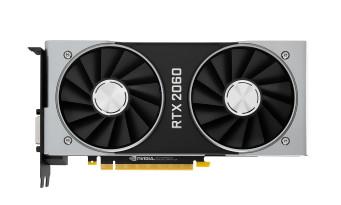 As with its big sisters, the RTX 2080 contains a Turing architecture chip at its heart, which means that we will be able to take advantage of the brand's new technologies, such as RTX (hardware-accelerated Ray-Tracing) as well as the DLSS (Deep Learning Super Sampling). If we have already largely poured out on the RTX, know that in the middle of the range, it is especially the DLSS which will be a sacred selling point. Thanks to this technology, an AI will in fact find ways to manage certain effects more simply, and thus free up computing power for something else. Thus, the anti-aliasing will for example be rendered in 720p before being upscaled, for a result comparable to the usual techniques where the borders are on the contrary calculated in 2K or 4K, before being brought back to a 1080p display. Thanks to DLSS, the GPU will be able to obtain the same effect by performing a rendering lower than the display definition, where before it was necessary to calculate a rendering higher than the display definition. With such a technique, it is therefore easy to imagine the enormous potential gains that DLSS will allow. You should know that the RTX 2060 is currently targeting the market of gamers who play at 1080p, but who still want to take advantage of Ultra graphics settings. For this, the 2060 therefore contains a TU106-300 chip which is in fact only a slightly castrated version of the Tu106-400 which equips the RTX 2070. Clearly, this card is equipped with the chip of the higher model, but with some elements disabled as you can see in the diagram below. This is a representation of the RTX 106 TU400-2070 chip elements where we have highlighted missing and/or disabled components in red to arrive at the RTX 106 TU300-2060.
As with its big sisters, the RTX 2080 contains a Turing architecture chip at its heart, which means that we will be able to take advantage of the brand's new technologies, such as RTX (hardware-accelerated Ray-Tracing) as well as the DLSS (Deep Learning Super Sampling). If we have already largely poured out on the RTX, know that in the middle of the range, it is especially the DLSS which will be a sacred selling point. Thanks to this technology, an AI will in fact find ways to manage certain effects more simply, and thus free up computing power for something else. Thus, the anti-aliasing will for example be rendered in 720p before being upscaled, for a result comparable to the usual techniques where the borders are on the contrary calculated in 2K or 4K, before being brought back to a 1080p display. Thanks to DLSS, the GPU will be able to obtain the same effect by performing a rendering lower than the display definition, where before it was necessary to calculate a rendering higher than the display definition. With such a technique, it is therefore easy to imagine the enormous potential gains that DLSS will allow. You should know that the RTX 2060 is currently targeting the market of gamers who play at 1080p, but who still want to take advantage of Ultra graphics settings. For this, the 2060 therefore contains a TU106-300 chip which is in fact only a slightly castrated version of the Tu106-400 which equips the RTX 2070. Clearly, this card is equipped with the chip of the higher model, but with some elements disabled as you can see in the diagram below. This is a representation of the RTX 106 TU400-2070 chip elements where we have highlighted missing and/or disabled components in red to arrive at the RTX 106 TU300-2060.
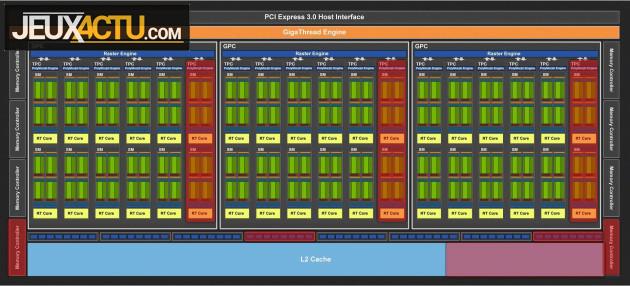
THE LITTLE WHO HAS EVERYTHING OF A BIG
 This 2060 therefore has 1920 CUDA cores (FP32 computing units) instead of the 2304 of its big sister, for a computing power of 6.5TFOPS instead of 7.5. Anyway, this new chip offers a displacement significantly higher than the mid-range of the previous generation, the RTX being able to boast of 10.8 billion transistors, where the GTX 1060 had to be satisfied with only 4.4 billion. In terms of frequencies, we remain slightly below the level of the 2070 or the 1060 with 1365 MHz base and 1680 MHz in boost. Of course, the card still has the GPU Boost which varies the frequency according to the workload, and the temperature. In our case, we saw our 2060 stabilize quietly at 1940 MHz, well above the announced values. If the Founder's Edition allows itself such performance, there is no doubt that third-party cards (MSI, ASUS, ZOTAC, EVGA) oriented gaming will do at least as well. As far as memory is concerned, this card retains 6GB of memory like the GTX 1060 it replaces, but it is now GDDR6 coupled with a 192-bit bus, which offers 336GB/s of bandwidth, or a large increase compared to the 192GB / s of the GTX 1060. At the RTX level, know that this 2060 has 30 dedicated units (called RT Cores), a little less than the RTX 2070 which has 36, and far of the 68 of the RTX 2080 Ti. It will therefore not be possible to abuse the effects of ray-tracing as we see below. In terms of DLSS, the finding is more encouraging, because the 2060 has 240 Tensor Cores (the units responsible for DLSS), which is not bad compared to the 288 of the RTX 2070, even if we remain far from the 544 of the 2080 Ti. On the other hand, where the RTX 2060 shines is on its energy sobriety. The mid-range RTX is content with a single 8-pin socket, for a load consumption of 160Watts, or 25 less than the 2070, or even 100 less than the 2080 Ti.
This 2060 therefore has 1920 CUDA cores (FP32 computing units) instead of the 2304 of its big sister, for a computing power of 6.5TFOPS instead of 7.5. Anyway, this new chip offers a displacement significantly higher than the mid-range of the previous generation, the RTX being able to boast of 10.8 billion transistors, where the GTX 1060 had to be satisfied with only 4.4 billion. In terms of frequencies, we remain slightly below the level of the 2070 or the 1060 with 1365 MHz base and 1680 MHz in boost. Of course, the card still has the GPU Boost which varies the frequency according to the workload, and the temperature. In our case, we saw our 2060 stabilize quietly at 1940 MHz, well above the announced values. If the Founder's Edition allows itself such performance, there is no doubt that third-party cards (MSI, ASUS, ZOTAC, EVGA) oriented gaming will do at least as well. As far as memory is concerned, this card retains 6GB of memory like the GTX 1060 it replaces, but it is now GDDR6 coupled with a 192-bit bus, which offers 336GB/s of bandwidth, or a large increase compared to the 192GB / s of the GTX 1060. At the RTX level, know that this 2060 has 30 dedicated units (called RT Cores), a little less than the RTX 2070 which has 36, and far of the 68 of the RTX 2080 Ti. It will therefore not be possible to abuse the effects of ray-tracing as we see below. In terms of DLSS, the finding is more encouraging, because the 2060 has 240 Tensor Cores (the units responsible for DLSS), which is not bad compared to the 288 of the RTX 2070, even if we remain far from the 544 of the 2080 Ti. On the other hand, where the RTX 2060 shines is on its energy sobriety. The mid-range RTX is content with a single 8-pin socket, for a load consumption of 160Watts, or 25 less than the 2070, or even 100 less than the 2080 Ti.
The other advantage of Nvidia cooling is of course its particularly polished aesthetics. Although it does not have the NVlink port which allows SLi, this 2060 has the appearance of the other Turing cards with superb finishes and a very attractive brushed aluminum backplate.
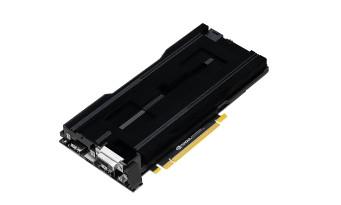 Thanks to this sobriety and its pretty Founder's Edition cooling which takes up the pair of axial fans, and the vapor chamber heatsink (a cavity where a liquid is evaporated at the bottom of the chamber in contact with the chip, which is the physical reaction which dissipates the most energy, before being condensed in the upper part), the RTX 2060 displays particularly low temperatures. Indeed, even by raising the consumption to 110% and overclocking the chip to 2.15Ghz, we did not observe a peak above 65°c, where a 2080Ti exceeds 80°c. That's pretty good news, because since the end of the "blower" design that blows hot air out of the case, Founder's Edition cards tend to raise the temperature inside your CPU. Here, it will therefore not be a problem, even if your tower is not the most ventilated. The other advantage of these contained temperatures is that the GPU boost can maintain very high frequencies, which guarantees high, but above all stable performance during long gaming sessions. The other advantage of Nvidia cooling, c is of course its particularly polished aesthetic. Although it does not have the NVlink port which allows SLi, the 2060 takes on the appearance of the other Turing cards with superb finishes and a very attractive brushed aluminum backplate. Looking closer, we realize that the PCB (the printed circuit) is also much shorter than the card itself, which leads us to think that we should quickly see very compact models arrive on the Marlet. The other advantage of these reduced dimensions is that the engineers had room to move the 8-pin power socket to the end of the card, instead of placing it on the side as usual, which will allow to better conceal the electrical cables.
Thanks to this sobriety and its pretty Founder's Edition cooling which takes up the pair of axial fans, and the vapor chamber heatsink (a cavity where a liquid is evaporated at the bottom of the chamber in contact with the chip, which is the physical reaction which dissipates the most energy, before being condensed in the upper part), the RTX 2060 displays particularly low temperatures. Indeed, even by raising the consumption to 110% and overclocking the chip to 2.15Ghz, we did not observe a peak above 65°c, where a 2080Ti exceeds 80°c. That's pretty good news, because since the end of the "blower" design that blows hot air out of the case, Founder's Edition cards tend to raise the temperature inside your CPU. Here, it will therefore not be a problem, even if your tower is not the most ventilated. The other advantage of these contained temperatures is that the GPU boost can maintain very high frequencies, which guarantees high, but above all stable performance during long gaming sessions. The other advantage of Nvidia cooling, c is of course its particularly polished aesthetic. Although it does not have the NVlink port which allows SLi, the 2060 takes on the appearance of the other Turing cards with superb finishes and a very attractive brushed aluminum backplate. Looking closer, we realize that the PCB (the printed circuit) is also much shorter than the card itself, which leads us to think that we should quickly see very compact models arrive on the Marlet. The other advantage of these reduced dimensions is that the engineers had room to move the 8-pin power socket to the end of the card, instead of placing it on the side as usual, which will allow to better conceal the electrical cables.
A MASTER CARD
 Once in play, the card surprises with its silence, which proves that the contained power consumption and the oversized cooling have their effect. No Coil Whine (this sharp noise emitted by the coils of the power supply stage) is perceptible, and we can already tell you that aficionados of silent configurations will flock to this 2060. Performance level, no surprises, no moreover, the mid-range Nvidia offer respects the hierarchy, and we have a card that comes between a GTX 1070Ti and a GTX 1080 in terms of power. Tested on our tower (i7 8700K and 32 GB of RAM) and with the display in 1080p, the card is simply the right choice with 7400 points on TimeSpy and 8543 points on the FireStrike Extreme. In game, we get 65 FPS on Shadow of the Tomb Raider in Ultra, 133 FPS on F1 2018, 120FPS on DOOM, 75 on GTA V and 90 on Battlefield V with RTX disabled. By activating it, the impact is immediately felt with 40FPS in Ultra, 50FPS in high, 60 FPS in normal, and 65FPS in low. It should be noted that the latest game update has improved performance significantly since our test of the 2080 Ti, and that further improvements are planned. Additionally, DICE's FPS does not yet support DLSS, but according to Nvidia, enabling the latter would yield huge performance gains, with nearly 90 FPS at 1080p and RTX set to ultra. This weakness in the face of Ray Tracing can easily be seen on the RTX Port Royal test by 3D Mark where the 2060 displays 800 points, while the 2080Ti comes out with 7800. VR level, no worries to be expected with nearly 14 frames rendered on the Steam test, a score that places it between the GTX 000 and the GTX 1070. By increasing the resolution, we logically see a drop in performance, but the 1080 remains possible for those who have a 2060p screen provided that they be ready to sacrifice between 1440 and 15 frames per second depending on the title. On the other hand, for 20K, it is going to be essential to plan the purchase of a more powerful model, since the 4 did not manage to reach 2060 FPS in most games, unless you sacrifice many graphics options. .
Once in play, the card surprises with its silence, which proves that the contained power consumption and the oversized cooling have their effect. No Coil Whine (this sharp noise emitted by the coils of the power supply stage) is perceptible, and we can already tell you that aficionados of silent configurations will flock to this 2060. Performance level, no surprises, no moreover, the mid-range Nvidia offer respects the hierarchy, and we have a card that comes between a GTX 1070Ti and a GTX 1080 in terms of power. Tested on our tower (i7 8700K and 32 GB of RAM) and with the display in 1080p, the card is simply the right choice with 7400 points on TimeSpy and 8543 points on the FireStrike Extreme. In game, we get 65 FPS on Shadow of the Tomb Raider in Ultra, 133 FPS on F1 2018, 120FPS on DOOM, 75 on GTA V and 90 on Battlefield V with RTX disabled. By activating it, the impact is immediately felt with 40FPS in Ultra, 50FPS in high, 60 FPS in normal, and 65FPS in low. It should be noted that the latest game update has improved performance significantly since our test of the 2080 Ti, and that further improvements are planned. Additionally, DICE's FPS does not yet support DLSS, but according to Nvidia, enabling the latter would yield huge performance gains, with nearly 90 FPS at 1080p and RTX set to ultra. This weakness in the face of Ray Tracing can easily be seen on the RTX Port Royal test by 3D Mark where the 2060 displays 800 points, while the 2080Ti comes out with 7800. VR level, no worries to be expected with nearly 14 frames rendered on the Steam test, a score that places it between the GTX 000 and the GTX 1070. By increasing the resolution, we logically see a drop in performance, but the 1080 remains possible for those who have a 2060p screen provided that they be ready to sacrifice between 1440 and 15 frames per second depending on the title. On the other hand, for 20K, it is going to be essential to plan the purchase of a more powerful model, since the 4 did not manage to reach 2060 FPS in most games, unless you sacrifice many graphics options. .
TO BUY OR NOT?
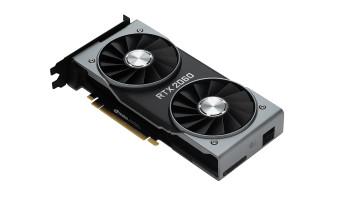 As always, the purchase of a graphics card depends on your needs, your attraction to new technologies and above all your financial means. On this point, remember that the GeForce RTX 2060 is sold for €370, which makes it for the moment the cheapest in the range, and by far. Although the price is higher than the launch price of the GTX 1060 it replaces, it turns out to be much closer to the 70 model than its predecessor in terms of performance. Indeed, the cheapest RTX 2070 is displayed at €540, which makes it worth €150 more for a 15% power boost. Clearly, if you're playing on a 1080p screen, and you don't want to blow your budget on a graphics card, the RTX 2060 remains the choice of reason, with an unbeatable price / performance ratio, even by going to ogle at AMD where the RX 590 which is 50% less powerful remains displayed at around 300€. If the average performance of the RTX on this card should not motivate your purchase, the promises made by the DLSS are on the other hand much more interesting.
As always, the purchase of a graphics card depends on your needs, your attraction to new technologies and above all your financial means. On this point, remember that the GeForce RTX 2060 is sold for €370, which makes it for the moment the cheapest in the range, and by far. Although the price is higher than the launch price of the GTX 1060 it replaces, it turns out to be much closer to the 70 model than its predecessor in terms of performance. Indeed, the cheapest RTX 2070 is displayed at €540, which makes it worth €150 more for a 15% power boost. Clearly, if you're playing on a 1080p screen, and you don't want to blow your budget on a graphics card, the RTX 2060 remains the choice of reason, with an unbeatable price / performance ratio, even by going to ogle at AMD where the RX 590 which is 50% less powerful remains displayed at around 300€. If the average performance of the RTX on this card should not motivate your purchase, the promises made by the DLSS are on the other hand much more interesting.
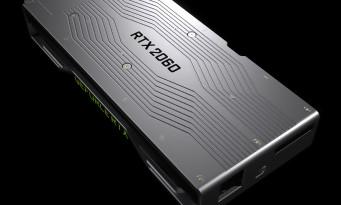 Indeed, given the announced gains, the RTX 2060 could well see its efficiency explode, to the point of offsetting the loss of performance linked to the RTX, or to increase the resolution or the framerate. Moreover, in the near future, we will benefit from significantly more games compatible with DLSS than with Ray Tracing since no less than 25 titles should accept. Unless you have a GTX 1070Ti or better, the charms of the RTX 2060 should easily make gamers give in, especially since the expense can be limited by reselling its old GPU. It should also be mentioned that those who decide quickly will be able, in passing, to recover a key for Battlefield V or Anthem, which further reinforces the quality/price ratio of this GPU. Even those who game at 1440p can consider the RTX 2060 a viable option, provided they accept some sacrifices on graphics quality. On the other hand, if you swear only by 4K, clearly go your way. The other advantage of this mid-range card is that it will be able to accept powerful but dated processors, or recent mid-range chips, without the risk of seeing its performance restricted.
Indeed, given the announced gains, the RTX 2060 could well see its efficiency explode, to the point of offsetting the loss of performance linked to the RTX, or to increase the resolution or the framerate. Moreover, in the near future, we will benefit from significantly more games compatible with DLSS than with Ray Tracing since no less than 25 titles should accept. Unless you have a GTX 1070Ti or better, the charms of the RTX 2060 should easily make gamers give in, especially since the expense can be limited by reselling its old GPU. It should also be mentioned that those who decide quickly will be able, in passing, to recover a key for Battlefield V or Anthem, which further reinforces the quality/price ratio of this GPU. Even those who game at 1440p can consider the RTX 2060 a viable option, provided they accept some sacrifices on graphics quality. On the other hand, if you swear only by 4K, clearly go your way. The other advantage of this mid-range card is that it will be able to accept powerful but dated processors, or recent mid-range chips, without the risk of seeing its performance restricted.
TECHNICAL SHEET
GPU Specs:1920 NVIDIA CUDA®37T RTX-OPS Cores5 Giga Rays/sec1680 Boost Frequency (MHz)1365 Base Frequency (MHz)
Memory Specifications:14 Gbps Memory Speed6 GB GDDR6 Standard Memory192-bit Memory Interface Size336 GB/sec Memory Bandwidth (GB/sec)
Technologies :Ray tracing en temps réelNVIDIA® GeForce ExperienceNVIDIA® AnselNVIDIA® HighlightsCompatibilité NVIDIA® G-SYNC™Pilotes Game ReadyMicrosoft® DirectX® 12 API, Vulkan API, OpenGL 4/5DisplayPort 1.4a, HDMI 2.0b 3HDCP 2.24 NVIDIA® GPU Boost™VR ReadyConception pour USB Type-C™ et VirtualLink™5
Display:7680x4320 Maximum digital resolution2DisplayPort, HDMI, USB Type-C™, DVI-DL Standard display connectors4 Multi Monitor2.2 HDCP
Graphics card dimensions:4.435” (112.6mm) Height9.0” (228.60mm) Length2-Slot Width
Thermal/Power Specifications:88 Maximum GPU Temperature (°C)160W Graphics Power Consumption (Watts)500W Recommended System Power (Watts) 4
8 pin Additional power connectors


























